An Analysis of Self-Monitoring of Blood Glucose in Diabetes Mellitus
VerifiedAdded on 2022/08/26
|8
|1482
|22
Report
AI Summary
This report provides a comprehensive analysis of self-monitoring of blood glucose (SMBG) in the management of diabetes mellitus. It begins with an introduction to SMBG, highlighting its significance as a tool for patients to monitor their blood glucose levels and make informed decisions about their treatment. The discussion section explores the value of SMBG, emphasizing its benefits in improving treatment adherence, assessing the impact of diet and exercise, identifying hypoglycemia risk, and fostering patient autonomy. The report then delves into the pitfalls and limitations of SMBG, including the absence of adequate patient education, inaccurate readings due to preanalytical errors, and interference from medications and environmental factors. The conclusion underscores the need for improved user-friendly devices, correct information about SMBG usage, and addressing the associated issues to leverage the benefits of SMBG effectively, ultimately supporting the treatment process and helping patients gain control over their care outcomes. The report references several studies to support its claims and provides a balanced perspective on the use of SMBG in diabetes management.
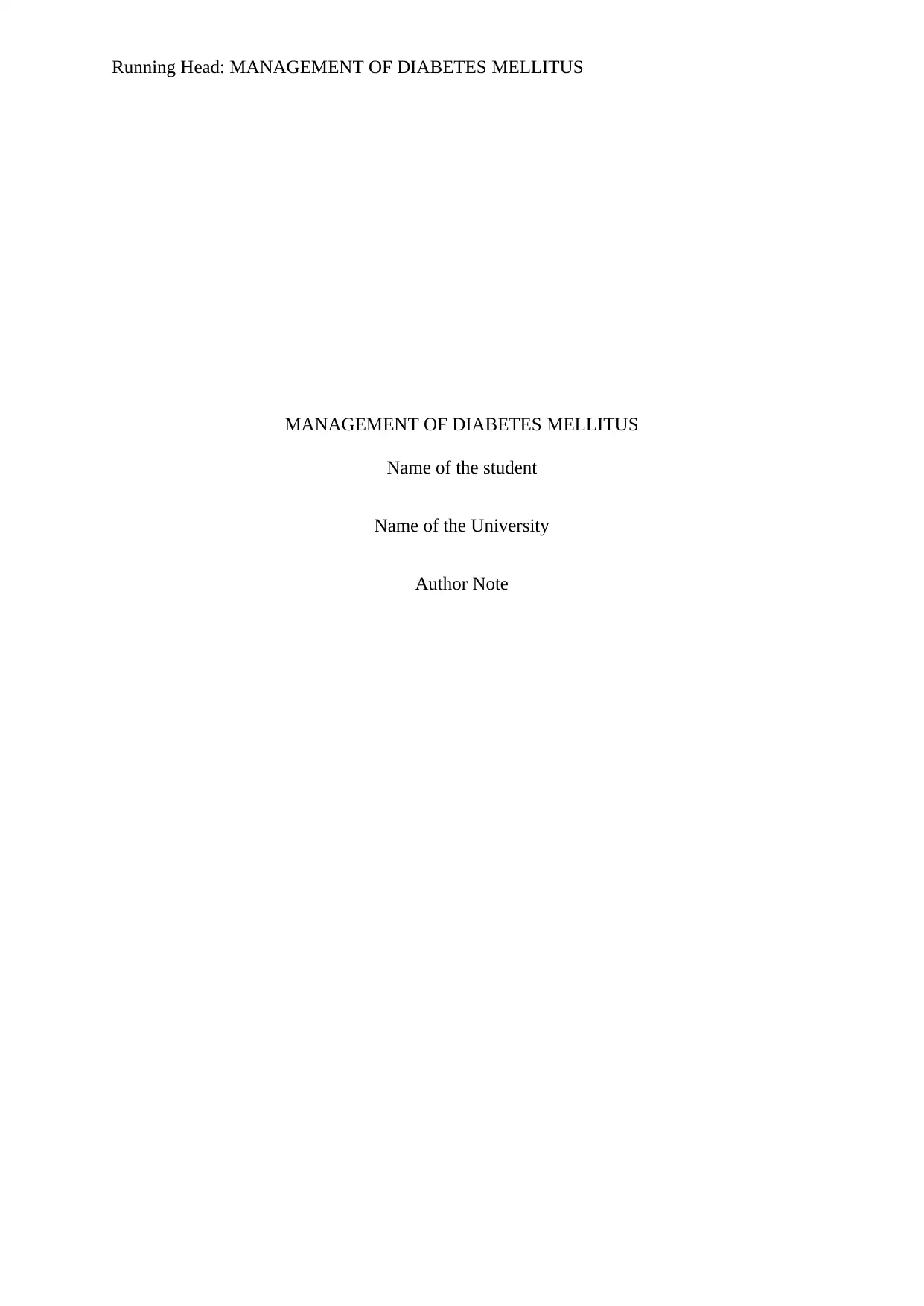
Running Head: MANAGEMENT OF DIABETES MELLITUS
MANAGEMENT OF DIABETES MELLITUS
Name of the student
Name of the University
Author Note
MANAGEMENT OF DIABETES MELLITUS
Name of the student
Name of the University
Author Note
Paraphrase This Document
Need a fresh take? Get an instant paraphrase of this document with our AI Paraphraser

1
MANAGEMENT OF DIABETES MELLITUS
Table of Contents
Introduction................................................................................................................................2
Discussion..................................................................................................................................2
Value of SMBG......................................................................................................................2
Pitfalls and limitations of SMBG...........................................................................................3
Conclusion..................................................................................................................................4
References..................................................................................................................................6
MANAGEMENT OF DIABETES MELLITUS
Table of Contents
Introduction................................................................................................................................2
Discussion..................................................................................................................................2
Value of SMBG......................................................................................................................2
Pitfalls and limitations of SMBG...........................................................................................3
Conclusion..................................................................................................................................4
References..................................................................................................................................6

2
MANAGEMENT OF DIABETES MELLITUS
Introduction
Self-monitoring of blood glucose (SMBG) is a tool of blood glucose measurement for
the patients of diabetes mellitus. It is promoted as a valued method in the long term diabetes
management. SMBG has several benefits, which might affect the treatment procedure, patient
outcome, and their wellbeing positively. By using SMBG, patients living with diabetes can
self assess their blood sugar levels using a glycemic reader, commonly called a glucometer or
with testing strips. They can modify, alter or check the efficacy of their ongoing treatment,
for example, their diet pattern, physical activity, insulin administration, and medicine
management, simply based on the reading given by the glucometer. However, regardless of
the multitude of advantages, few grave concerns reduce the potential of SMBG as a useful
monitoring aid. This paper aims to elucidate the value, pitfalls, and limitations of self-
monitoring of capillary blood glucose.
Discussion
Value of SMBG
Self-monitoring the blood glucose levels is a cornerstone of diabetes mellitus
treatment because of its conventional advantages over other methods like HbA1c, which is
the standard method to assess blood glucose, but cannot be relied on to produce real-time
results. Hence, SMBG is frequently utilized by several patients for better adherence to the
treatment plan and to achieve their target blood glucose through regular checking. There are
different benefits of capillary blood glucose monitoring that ultimately may help to improve
the treatment outcome and motivate the patient to keep their blood glucose levels under
control. SMBG assists the patient to understand the efficiency of their treatment plan
including diet and exercise management, to evaluate the impact of various foods on their
blood glucose levels, identify if they are at the risk of developing hypoglycemia (blood
MANAGEMENT OF DIABETES MELLITUS
Introduction
Self-monitoring of blood glucose (SMBG) is a tool of blood glucose measurement for
the patients of diabetes mellitus. It is promoted as a valued method in the long term diabetes
management. SMBG has several benefits, which might affect the treatment procedure, patient
outcome, and their wellbeing positively. By using SMBG, patients living with diabetes can
self assess their blood sugar levels using a glycemic reader, commonly called a glucometer or
with testing strips. They can modify, alter or check the efficacy of their ongoing treatment,
for example, their diet pattern, physical activity, insulin administration, and medicine
management, simply based on the reading given by the glucometer. However, regardless of
the multitude of advantages, few grave concerns reduce the potential of SMBG as a useful
monitoring aid. This paper aims to elucidate the value, pitfalls, and limitations of self-
monitoring of capillary blood glucose.
Discussion
Value of SMBG
Self-monitoring the blood glucose levels is a cornerstone of diabetes mellitus
treatment because of its conventional advantages over other methods like HbA1c, which is
the standard method to assess blood glucose, but cannot be relied on to produce real-time
results. Hence, SMBG is frequently utilized by several patients for better adherence to the
treatment plan and to achieve their target blood glucose through regular checking. There are
different benefits of capillary blood glucose monitoring that ultimately may help to improve
the treatment outcome and motivate the patient to keep their blood glucose levels under
control. SMBG assists the patient to understand the efficiency of their treatment plan
including diet and exercise management, to evaluate the impact of various foods on their
blood glucose levels, identify if they are at the risk of developing hypoglycemia (blood
⊘ This is a preview!⊘
Do you want full access?
Subscribe today to unlock all pages.

Trusted by 1+ million students worldwide
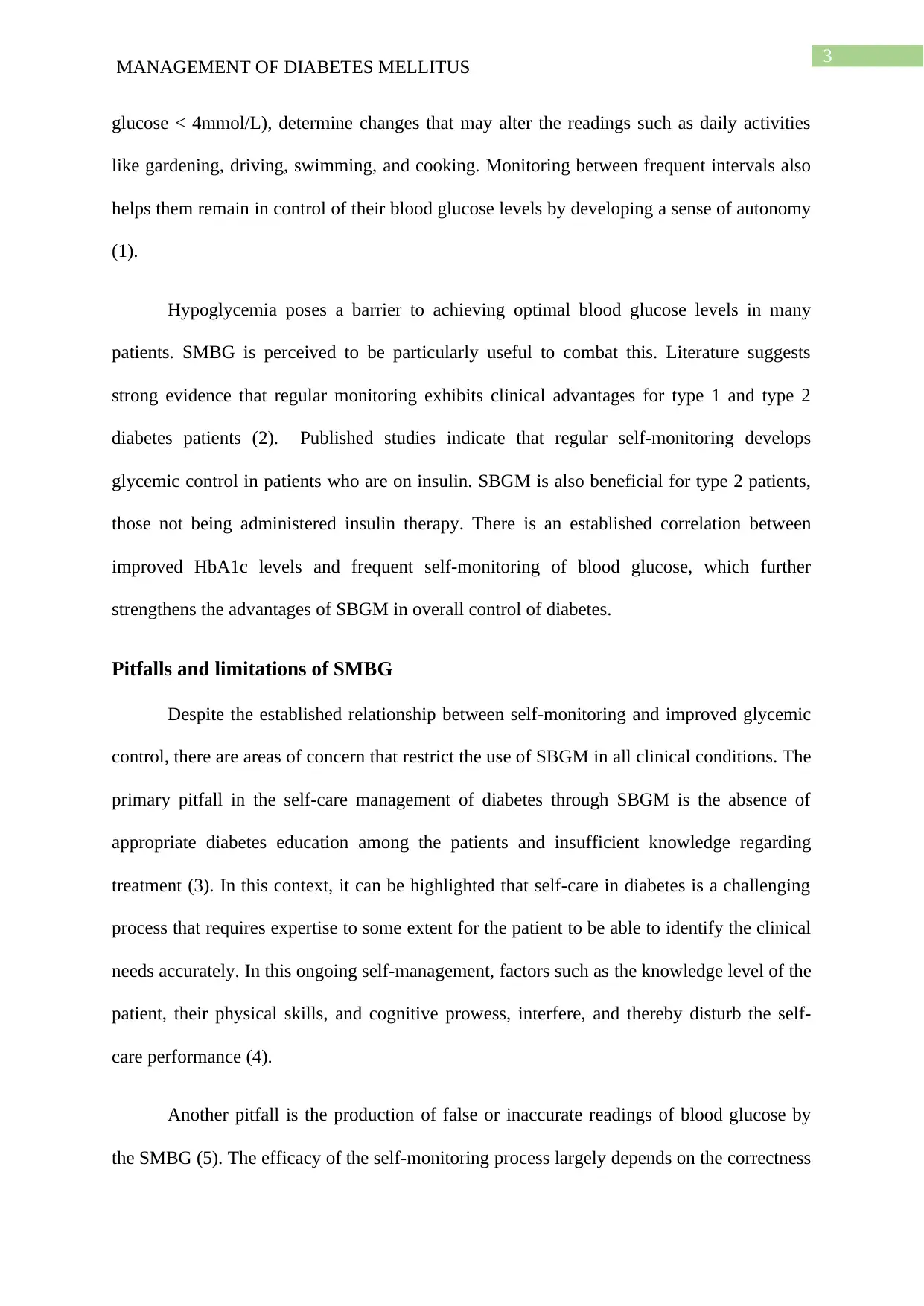
3
MANAGEMENT OF DIABETES MELLITUS
glucose < 4mmol/L), determine changes that may alter the readings such as daily activities
like gardening, driving, swimming, and cooking. Monitoring between frequent intervals also
helps them remain in control of their blood glucose levels by developing a sense of autonomy
(1).
Hypoglycemia poses a barrier to achieving optimal blood glucose levels in many
patients. SMBG is perceived to be particularly useful to combat this. Literature suggests
strong evidence that regular monitoring exhibits clinical advantages for type 1 and type 2
diabetes patients (2). Published studies indicate that regular self-monitoring develops
glycemic control in patients who are on insulin. SBGM is also beneficial for type 2 patients,
those not being administered insulin therapy. There is an established correlation between
improved HbA1c levels and frequent self-monitoring of blood glucose, which further
strengthens the advantages of SBGM in overall control of diabetes.
Pitfalls and limitations of SMBG
Despite the established relationship between self-monitoring and improved glycemic
control, there are areas of concern that restrict the use of SBGM in all clinical conditions. The
primary pitfall in the self-care management of diabetes through SBGM is the absence of
appropriate diabetes education among the patients and insufficient knowledge regarding
treatment (3). In this context, it can be highlighted that self-care in diabetes is a challenging
process that requires expertise to some extent for the patient to be able to identify the clinical
needs accurately. In this ongoing self-management, factors such as the knowledge level of the
patient, their physical skills, and cognitive prowess, interfere, and thereby disturb the self-
care performance (4).
Another pitfall is the production of false or inaccurate readings of blood glucose by
the SMBG (5). The efficacy of the self-monitoring process largely depends on the correctness
MANAGEMENT OF DIABETES MELLITUS
glucose < 4mmol/L), determine changes that may alter the readings such as daily activities
like gardening, driving, swimming, and cooking. Monitoring between frequent intervals also
helps them remain in control of their blood glucose levels by developing a sense of autonomy
(1).
Hypoglycemia poses a barrier to achieving optimal blood glucose levels in many
patients. SMBG is perceived to be particularly useful to combat this. Literature suggests
strong evidence that regular monitoring exhibits clinical advantages for type 1 and type 2
diabetes patients (2). Published studies indicate that regular self-monitoring develops
glycemic control in patients who are on insulin. SBGM is also beneficial for type 2 patients,
those not being administered insulin therapy. There is an established correlation between
improved HbA1c levels and frequent self-monitoring of blood glucose, which further
strengthens the advantages of SBGM in overall control of diabetes.
Pitfalls and limitations of SMBG
Despite the established relationship between self-monitoring and improved glycemic
control, there are areas of concern that restrict the use of SBGM in all clinical conditions. The
primary pitfall in the self-care management of diabetes through SBGM is the absence of
appropriate diabetes education among the patients and insufficient knowledge regarding
treatment (3). In this context, it can be highlighted that self-care in diabetes is a challenging
process that requires expertise to some extent for the patient to be able to identify the clinical
needs accurately. In this ongoing self-management, factors such as the knowledge level of the
patient, their physical skills, and cognitive prowess, interfere, and thereby disturb the self-
care performance (4).
Another pitfall is the production of false or inaccurate readings of blood glucose by
the SMBG (5). The efficacy of the self-monitoring process largely depends on the correctness
Paraphrase This Document
Need a fresh take? Get an instant paraphrase of this document with our AI Paraphraser

4
MANAGEMENT OF DIABETES MELLITUS
of the measurement results. Factors like preanalytical application errors, unfavorable
environmental circumstances, abnormal hematocrit values, or interaction with medications
may potentially misrepresent the blood glucose levels. Such incorrect readings further lead to
wrong treatment and care management. Inapt handling of self-monitoring devices is
identified as the most prevalent cause of false blood glucose readings. The minute blood
samples used by the advanced glucometers may get contaminated even with the presence of a
minor amount of fluids containing glucose such as traces of fruits or fruit juices on the skin,
that falsely escalate the measurement.
Interference with various medications may be another limitation in the usage of
SMBG. A study conducted on 30 substances observed a deviation in blood glucose readings
to be possibly impacted by ascorbic acid, dopamine, acetaminophen, mannitol, and maltose
drugs (5). Other preanalytical factors that may potentially interfere with the SBGM are errors
in coding and calibration procedure inside the testing instrument, and error due to the use of
deteriorated glucose test strips resulting from improper storage or mechanical handling that
reduces reliability (6). Beyond these technical mishandlings, human errors could be another
factor associated with SMBG inaccuracy.
Environmental factors that interfere with the SMBG process are the influence of high
temperature or humidity that alters the components of the test strips (7). Physiological factors
include high or low levels of hematocrit, reduced peripheral blood perfusion, and increased
triglycerides and uric acid in the blood, which may falsify the SMBG readings by causing
interaction (8). All of these factors substantially affect the reliability, accuracy, and efficacy
of self-monitoring procedures, thereby accelerating its drawbacks and shortages in clinical
management.
MANAGEMENT OF DIABETES MELLITUS
of the measurement results. Factors like preanalytical application errors, unfavorable
environmental circumstances, abnormal hematocrit values, or interaction with medications
may potentially misrepresent the blood glucose levels. Such incorrect readings further lead to
wrong treatment and care management. Inapt handling of self-monitoring devices is
identified as the most prevalent cause of false blood glucose readings. The minute blood
samples used by the advanced glucometers may get contaminated even with the presence of a
minor amount of fluids containing glucose such as traces of fruits or fruit juices on the skin,
that falsely escalate the measurement.
Interference with various medications may be another limitation in the usage of
SMBG. A study conducted on 30 substances observed a deviation in blood glucose readings
to be possibly impacted by ascorbic acid, dopamine, acetaminophen, mannitol, and maltose
drugs (5). Other preanalytical factors that may potentially interfere with the SBGM are errors
in coding and calibration procedure inside the testing instrument, and error due to the use of
deteriorated glucose test strips resulting from improper storage or mechanical handling that
reduces reliability (6). Beyond these technical mishandlings, human errors could be another
factor associated with SMBG inaccuracy.
Environmental factors that interfere with the SMBG process are the influence of high
temperature or humidity that alters the components of the test strips (7). Physiological factors
include high or low levels of hematocrit, reduced peripheral blood perfusion, and increased
triglycerides and uric acid in the blood, which may falsify the SMBG readings by causing
interaction (8). All of these factors substantially affect the reliability, accuracy, and efficacy
of self-monitoring procedures, thereby accelerating its drawbacks and shortages in clinical
management.
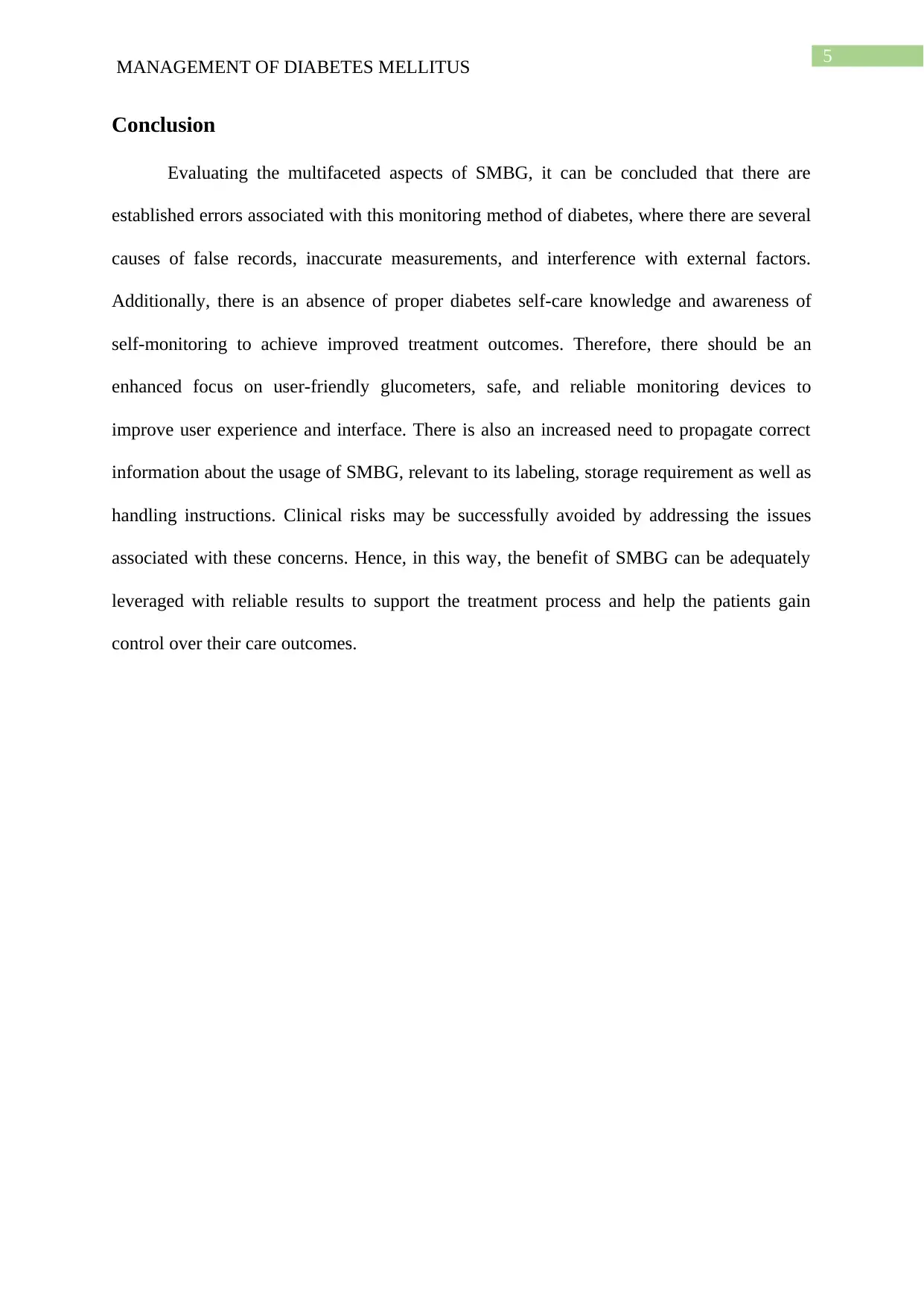
5
MANAGEMENT OF DIABETES MELLITUS
Conclusion
Evaluating the multifaceted aspects of SMBG, it can be concluded that there are
established errors associated with this monitoring method of diabetes, where there are several
causes of false records, inaccurate measurements, and interference with external factors.
Additionally, there is an absence of proper diabetes self-care knowledge and awareness of
self-monitoring to achieve improved treatment outcomes. Therefore, there should be an
enhanced focus on user-friendly glucometers, safe, and reliable monitoring devices to
improve user experience and interface. There is also an increased need to propagate correct
information about the usage of SMBG, relevant to its labeling, storage requirement as well as
handling instructions. Clinical risks may be successfully avoided by addressing the issues
associated with these concerns. Hence, in this way, the benefit of SMBG can be adequately
leveraged with reliable results to support the treatment process and help the patients gain
control over their care outcomes.
MANAGEMENT OF DIABETES MELLITUS
Conclusion
Evaluating the multifaceted aspects of SMBG, it can be concluded that there are
established errors associated with this monitoring method of diabetes, where there are several
causes of false records, inaccurate measurements, and interference with external factors.
Additionally, there is an absence of proper diabetes self-care knowledge and awareness of
self-monitoring to achieve improved treatment outcomes. Therefore, there should be an
enhanced focus on user-friendly glucometers, safe, and reliable monitoring devices to
improve user experience and interface. There is also an increased need to propagate correct
information about the usage of SMBG, relevant to its labeling, storage requirement as well as
handling instructions. Clinical risks may be successfully avoided by addressing the issues
associated with these concerns. Hence, in this way, the benefit of SMBG can be adequately
leveraged with reliable results to support the treatment process and help the patients gain
control over their care outcomes.
⊘ This is a preview!⊘
Do you want full access?
Subscribe today to unlock all pages.

Trusted by 1+ million students worldwide
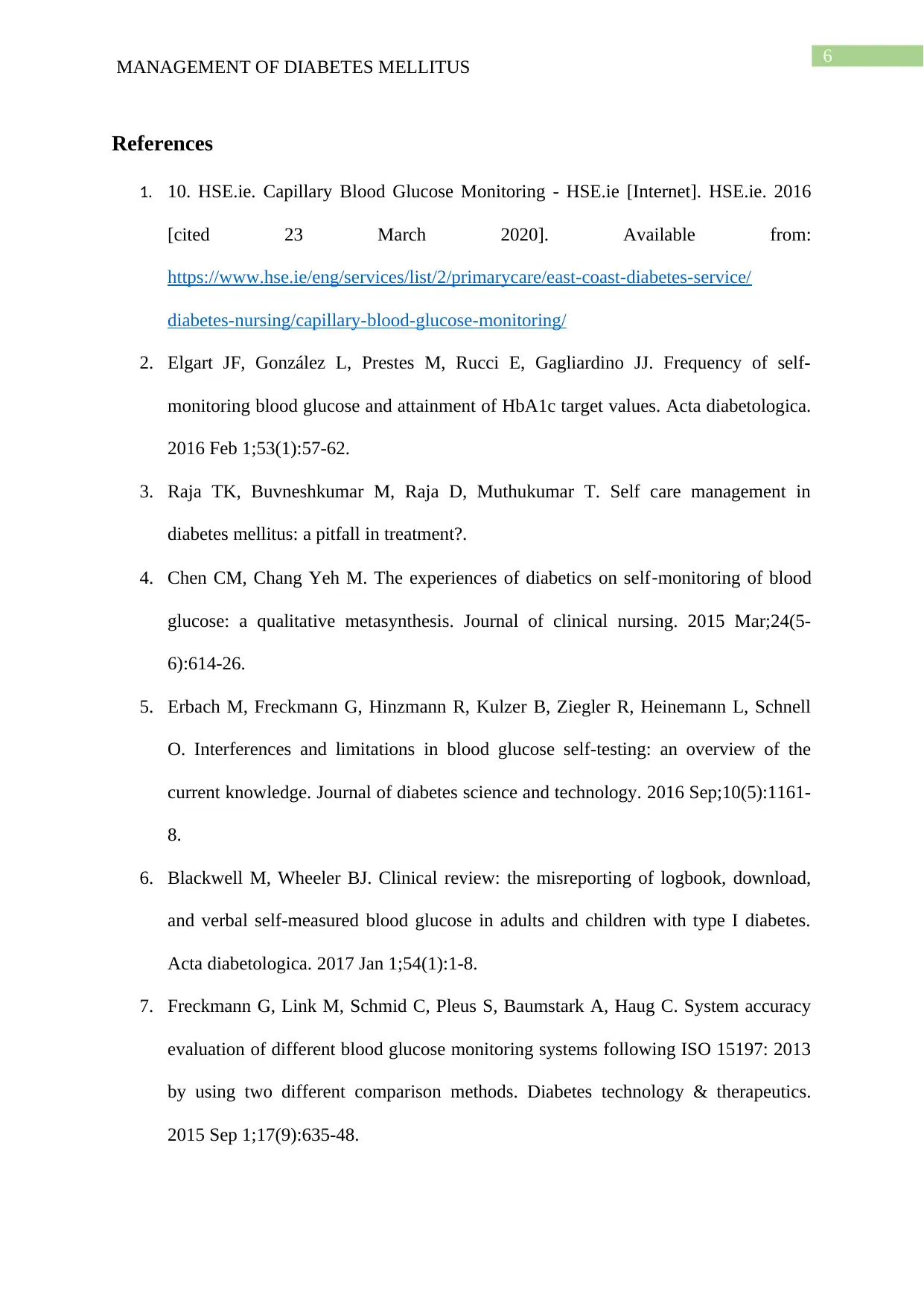
6
MANAGEMENT OF DIABETES MELLITUS
References
1. 10. HSE.ie. Capillary Blood Glucose Monitoring - HSE.ie [Internet]. HSE.ie. 2016
[cited 23 March 2020]. Available from:
https://www.hse.ie/eng/services/list/2/primarycare/east-coast-diabetes-service/
diabetes-nursing/capillary-blood-glucose-monitoring/
2. Elgart JF, González L, Prestes M, Rucci E, Gagliardino JJ. Frequency of self-
monitoring blood glucose and attainment of HbA1c target values. Acta diabetologica.
2016 Feb 1;53(1):57-62.
3. Raja TK, Buvneshkumar M, Raja D, Muthukumar T. Self care management in
diabetes mellitus: a pitfall in treatment?.
4. Chen CM, Chang Yeh M. The experiences of diabetics on self‐monitoring of blood
glucose: a qualitative metasynthesis. Journal of clinical nursing. 2015 Mar;24(5-
6):614-26.
5. Erbach M, Freckmann G, Hinzmann R, Kulzer B, Ziegler R, Heinemann L, Schnell
O. Interferences and limitations in blood glucose self-testing: an overview of the
current knowledge. Journal of diabetes science and technology. 2016 Sep;10(5):1161-
8.
6. Blackwell M, Wheeler BJ. Clinical review: the misreporting of logbook, download,
and verbal self-measured blood glucose in adults and children with type I diabetes.
Acta diabetologica. 2017 Jan 1;54(1):1-8.
7. Freckmann G, Link M, Schmid C, Pleus S, Baumstark A, Haug C. System accuracy
evaluation of different blood glucose monitoring systems following ISO 15197: 2013
by using two different comparison methods. Diabetes technology & therapeutics.
2015 Sep 1;17(9):635-48.
MANAGEMENT OF DIABETES MELLITUS
References
1. 10. HSE.ie. Capillary Blood Glucose Monitoring - HSE.ie [Internet]. HSE.ie. 2016
[cited 23 March 2020]. Available from:
https://www.hse.ie/eng/services/list/2/primarycare/east-coast-diabetes-service/
diabetes-nursing/capillary-blood-glucose-monitoring/
2. Elgart JF, González L, Prestes M, Rucci E, Gagliardino JJ. Frequency of self-
monitoring blood glucose and attainment of HbA1c target values. Acta diabetologica.
2016 Feb 1;53(1):57-62.
3. Raja TK, Buvneshkumar M, Raja D, Muthukumar T. Self care management in
diabetes mellitus: a pitfall in treatment?.
4. Chen CM, Chang Yeh M. The experiences of diabetics on self‐monitoring of blood
glucose: a qualitative metasynthesis. Journal of clinical nursing. 2015 Mar;24(5-
6):614-26.
5. Erbach M, Freckmann G, Hinzmann R, Kulzer B, Ziegler R, Heinemann L, Schnell
O. Interferences and limitations in blood glucose self-testing: an overview of the
current knowledge. Journal of diabetes science and technology. 2016 Sep;10(5):1161-
8.
6. Blackwell M, Wheeler BJ. Clinical review: the misreporting of logbook, download,
and verbal self-measured blood glucose in adults and children with type I diabetes.
Acta diabetologica. 2017 Jan 1;54(1):1-8.
7. Freckmann G, Link M, Schmid C, Pleus S, Baumstark A, Haug C. System accuracy
evaluation of different blood glucose monitoring systems following ISO 15197: 2013
by using two different comparison methods. Diabetes technology & therapeutics.
2015 Sep 1;17(9):635-48.
Paraphrase This Document
Need a fresh take? Get an instant paraphrase of this document with our AI Paraphraser
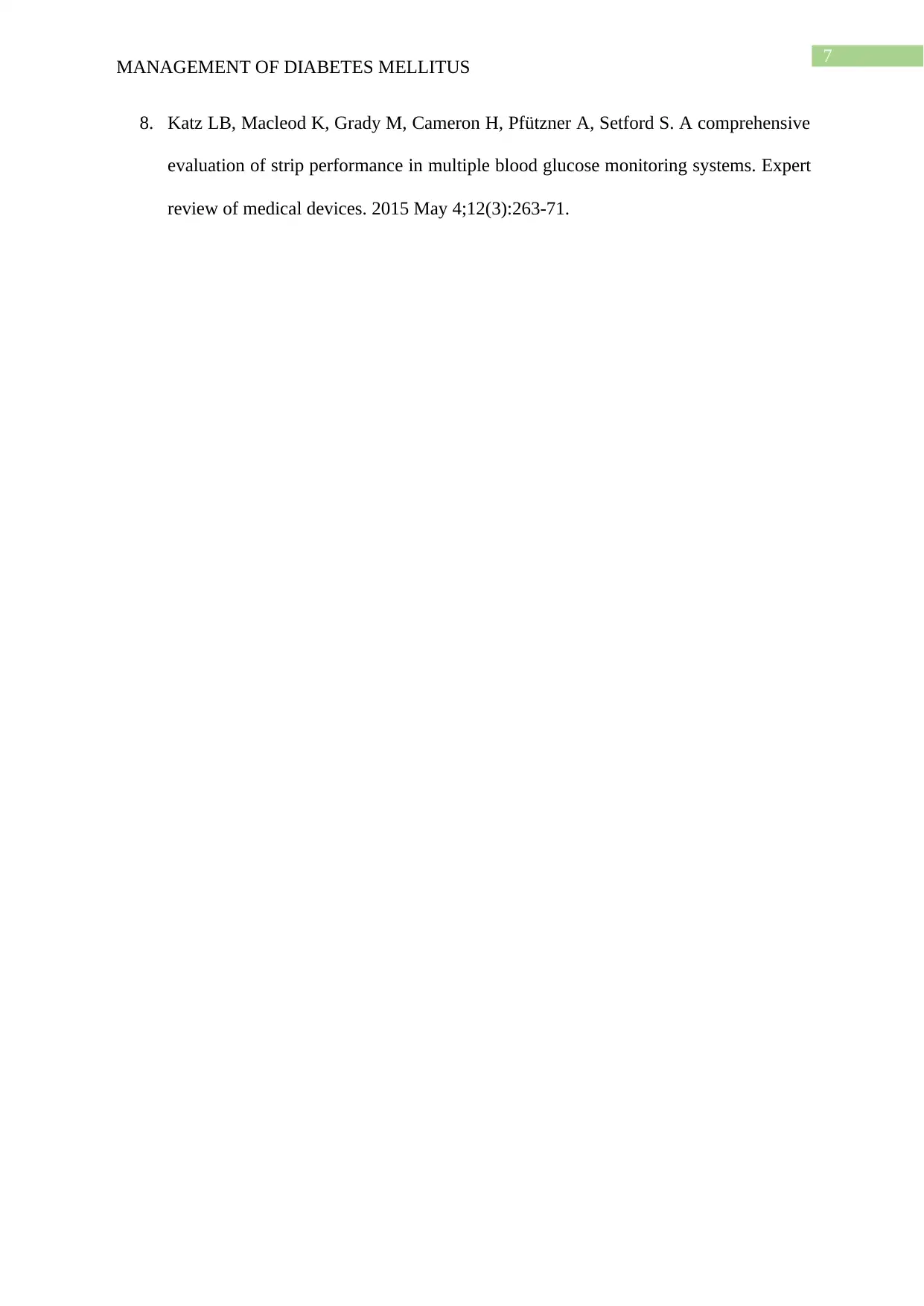
7
MANAGEMENT OF DIABETES MELLITUS
8. Katz LB, Macleod K, Grady M, Cameron H, Pfützner A, Setford S. A comprehensive
evaluation of strip performance in multiple blood glucose monitoring systems. Expert
review of medical devices. 2015 May 4;12(3):263-71.
MANAGEMENT OF DIABETES MELLITUS
8. Katz LB, Macleod K, Grady M, Cameron H, Pfützner A, Setford S. A comprehensive
evaluation of strip performance in multiple blood glucose monitoring systems. Expert
review of medical devices. 2015 May 4;12(3):263-71.
1 out of 8
Related Documents
Your All-in-One AI-Powered Toolkit for Academic Success.
+13062052269
info@desklib.com
Available 24*7 on WhatsApp / Email
![[object Object]](/_next/static/media/star-bottom.7253800d.svg)
Unlock your academic potential
Copyright © 2020–2025 A2Z Services. All Rights Reserved. Developed and managed by ZUCOL.




